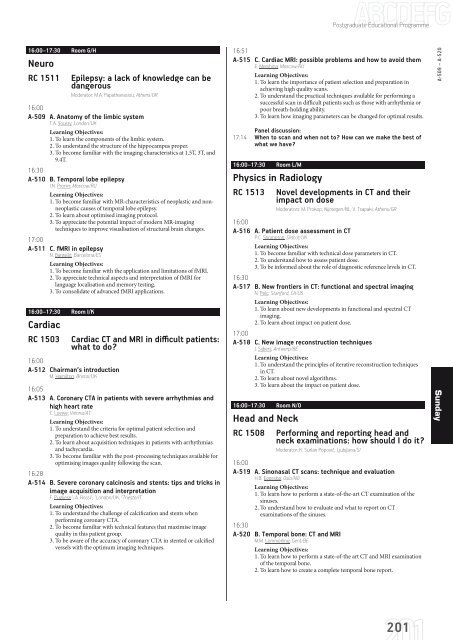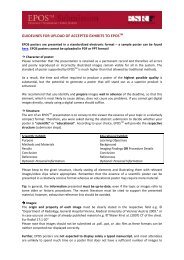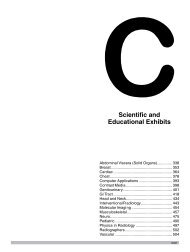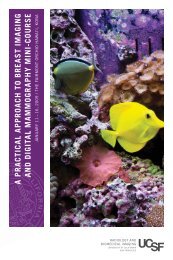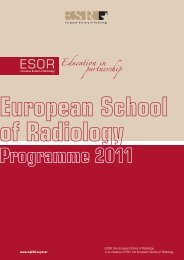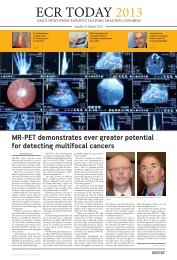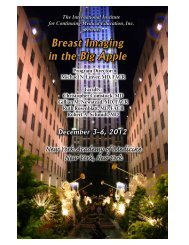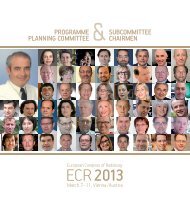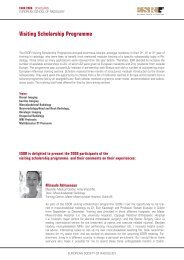ECR 2013 â Final Programme - myESR.org
ECR 2013 â Final Programme - myESR.org
ECR 2013 â Final Programme - myESR.org
- No tags were found...
Create successful ePaper yourself
Turn your PDF publications into a flip-book with our unique Google optimized e-Paper software.
Postgraduate Educational <strong>Programme</strong>16:00–17:30 Room G/HNeuroRC 1511Epilepsy: a lack of knowledge can bedangerousModerator: M.A. Papathanasiou; Athens/GR16:00A-509 A. Anatomy of the limbic systemT.A. Yousry; London/UKLearning Objectives:1. To learn the components of the limbic system.2. To understand the structure of the hippocampus proper.3. To become familiar with the imaging characteristics at 1.5T, 3T, and9.4T.16:30A-510 B. Temporal lobe epilepsyI.N. Pronin; Moscow/RULearning Objectives:1. To become familiar with MR-characteristics of neoplastic and nonneoplasticcauses of temporal lobe epilepsy.2. To learn about optimised imaging protocol.3. To appreciate the potential impact of modern MR-imagingtechniques to improve visualisation of structural brain changes.17:00A-511 C. fMRI in epilepsyN. Bargalló; Barcelona/ESLearning Objectives:1. To become familiar with the application and limitations of fMRI.2. To appreciate technical aspects and interpretation of fMRI forlanguage localisation and memory testing.3. To consolidate of advanced fMRI applications.16:00–17:30 Room I/KCardiacRC 1503Cardiac CT and MRI in difficult patients:what to do?16:00A-512 Chairman‘s introductionM. Hamilton; Bristol/UK16:05A-513 A. Coronary CTA in patients with severe arrhythmias andhigh heart rateC. Loewe; Vienna/ATLearning Objectives:1. To understand the criteria for optimal patient selection andpreparation to achieve best results.2. To learn about acquisition techniques in patients with arrhythmiasand tachycardia.3. To become familiar with the post-processing techniques available foroptimising images quality following the scan.16:28A-514 B. Severe coronary calcinosis and stents: tips and tricks inimage acquisition and interpretationF. Pugliese 1 , A. Rossi 2 ; 1 London/UK, 2 Trieste/ITLearning Objectives:1. To understand the challenge of calcification and stents whenperforming coronary CTA.2. To become familiar with technical features that maximise imagequality in this patient group.3. To be aware of the accuracy of coronary CTA in stented or calcifiedvessels with the optimum imaging techniques.16:51A-515 C. Cardiac MRI: possible problems and how to avoid themE. Mershina; Moscow/RULearning Objectives:1. To learn the importance of patient selection and preparation inachieving high quality scans.2. To understand the practical techniques available for performing asuccessful scan in difficult patients such as those with arrhythmia orpoor breath-holding ability.3. To learn how imaging parameters can be changed for optimal results.Panel discussion:17:14 When to scan and when not to? How can we make the best ofwhat we have?16:00–17:30 Room L/MPhysics in RadiologyRC 1513 Novel developments in CT and theirimpact on doseModerators: M. Prokop; Nijmegen/NL, V. Tsapaki; Athens/GR16:00A-516 A. Patient dose assessment in CTP.C. Shrimpton; Didcot/UKLearning Objectives:1. To become familiar with technical dose parameters in CT.2. To understand how to assess patient dose.3. To be informed about the role of diagnostic reference levels in CT.16:30A-517 B. New frontiers in CT: functional and spectral imagingN. Pelc; Stanford, CA/USLearning Objectives:1. To learn about new developments in functional and spectral CTimaging.2. To learn about impact on patient dose.17:00A-518 C. New image reconstruction techniquesJ. Sijbers; Antwerp/BELearning Objectives:1. To understand the principles of iterative reconstruction techniquesin CT.2. To learn about novel algorithms.3. To learn about the impact on patient dose.16:00–17:30 Room N/OHead and NeckRC 1508 Performing and reporting head andneck examinations: how should I do it?Moderator: K. Surlan Popovič; Ljubljana/SI16:00A-519 A. Sinonasal CT scans: technique and evaluationH.B. Eggesbø; Oslo/NOLearning Objectives:1. To learn how to perform a state-of-the-art CT examination of thesinuses.2. To understand how to evaluate and what to report on CTexaminations of the sinuses.16:30A-520 B. Temporal bone: CT and MRIM.M. Lemmerling; Gent/BELearning Objectives:1. To learn how to perform a state-of-the art CT and MRI examinationof the temporal bone.2. To learn how to create a complete temporal bone report.A-509 – A-520Sunday201


